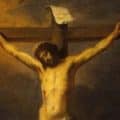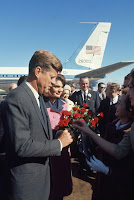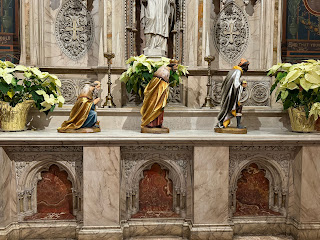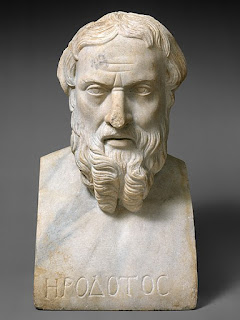For my « Baby Boomer » generation, maybe no event stands out so memorably as the assassination of President John F. Kennedy in Dallas, TX, sixty years ago today. It was undeniably the defining national trauma of my high school years.
Like Caesar in ancient Gaul, I look back on the 1960s as divided into three parts – the fantasized “Camelot” sixties that began with Kennedy’s election and inauguration and ended so tragically and dramatically in Dallas in 1963, the “Great Society” sixties that lasted until the “off-year” election of 1966, and then the revolutionary sixties, the highpoint of which was the terrible (but so exciting to have lived through) year 1968, after which the sixties seemed to limp on to a somewhat tepid and inglorious end in the Nixon years. (In my personal life, those years chronologically correspond almost exactly to high school, personal failure and recovery, college, and graduate school.)
We were in high school English class that now infamous Friday afternoon, November 22, 1963. It was the last period, and the principal had already made his customary end-of-day announcements over the loudspeaker. Suddenly, he came back on and said, “We ask you to remember in your prayers …” I immediately thought that some student’s parent had died or was seriously sick, because that was how such announcements usually began. But then he continued, “… the President of the United States, who has been shot.” Our English teacher looked up and said, “I thought they didn’t do that in this country.” As we walked home from school, some of us talked somberly about what had happened and what would happen with a new president. At home, I went straight upstairs – no lingering that day. As I entered our apartment, my grandmother told me that the President had been shot. I told her I’d already heard and then turned on the TV, where I heard the announcement, “John Fitzgerald Kennedy, the 35th President of the United States, is dead.” I then went back to my grandmother and told her, “E morto, il presidente è morto.”
Anyone who was alive and old enough then can likely remember such amazingly miniscule details of what was one of the defining events of my generation. I can remember leaving the TV on and listening briefly to some talking head speculating whether we were in for another period of anarchist activity as had happened at the turn of the 20 century! (I guess academics just can’t help themselves!). Then my mother rang from downstairs and I went down as usual to help her lift the baby carriage with my sister Christine in it up the entranceway stairs and into the elevator. It was already dark by the time my father came home from work, somberly carrying a now obsolete pre-assassination edition of the New York Journal American. A few minutes later, one of us looked out the window and saw that a more up-to-date extra edition had arrived, and he sent me down to buy one, just to have it. Then, after supper, we all watched the late President’s body arrive at Andrews Air Force Base and heard the new President’s simple and comforting first words to the nation.
And, thus, it continued for four unbelievable days – days of national public pomp and solemnity we had seldom seen before. I still associate Hail to the Chief (played on that occasion at 88 beats per minute instead of the customary 120) and the naval hymn Eternal Father, Strong to Save (which I had never heard before then) with those sadly solemn and strangely powerful ceremonies! As Catholics, of course, we were all acutely sensitive to the religious dimension of this civic state ceremonial – the private Mass in the White House East Room, the presence of priests in the funeral procession, and above all the pontifical Requiem Mass at Washington’s Saint Matthew’s Cathedral on Monday. Liturgical enthusiast that I then was, I was genuinely disappointed that it was a Low Mass. High or Low, it was definitely not the traditional Catholic liturgy at its best. But, at the time, we were all for the most part proud to see a Cardinal celebrating a Catholic Mass for the largest national TV audience ever yet!
Of course, Kennedy was historically an odd figure for such Catholic pride. As Jacqueline Kennedy famously had said to Arthur Krock: “I think it is unfair for Jack to be opposed because he is a Catholic. After all, he’s such a poor Catholic. Now if it were Bobby: he never misses mass and prays all the time.” Murray Kempton had put it more caustically back in 1960, when he wrote: “We have once again been cheated of the prospect of a Catholic president.”
In any case, if Kennedy’s Requiem was the first Catholic Mass to be seen by such a large TV audience, it was also one of the last of its type, since so much of that timeless ritual would be lost in the liturgical transformation none of us as yet anticipated but which would very quickly come upon us with the force of an unstoppable storm. That is just one more way in which that incomparably traumatic weekend really proved to be a liminal line between the more distant past and the now less past, between post-war national self-confidence and the universal loss of confidence that started in the 1960s and has grown ever since.
Neither then nor since have I been at all attracted to any of the many and various conspiracy theories that have had such seemingly widespread currency in these 60 years. (I recently read somewhere that some 65% of the American population believe in some version of Kennedy-assassination conspiracy.) In retrospect, I suppose that the salience of such conspiratorial thinking was consonant with tendencies that have long been present in American culture and which may have anticipated the far more dangerous conspiratorial tendencies that have run riot in our deeply disordered present time.





